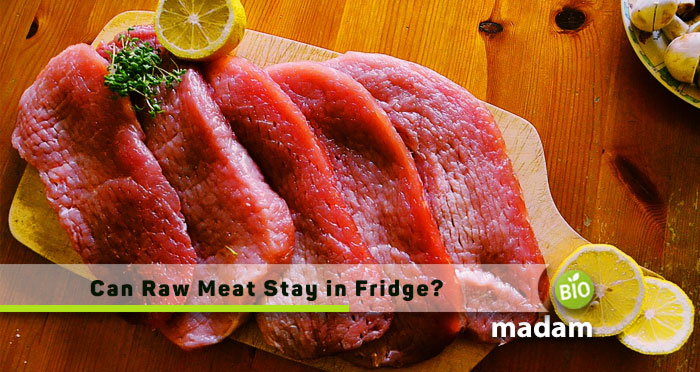Purchasing meat for a meal can be costly, so you don’t want any of it to go to waste. There are a lot of food safety considerations to keep in mind to keep it fresh. You can retain your kitchen well-stocked for days, weeks, and even months by storing it in the refrigerator or freezer.
Meats including raw poultry, steaks, bacon, and corned beef all have precise storage times specified by the U.S. Food & Drug Administration (FDA). So you know how long you can keep the ham you bought in the fridge or freezer.
Bacterial development can be slowed but not prevented by refrigerating food. As a result, food should be consumed as soon as possible to avoid spoilage or risk. Just one to two days before cooking or freezing raw ground meats such as ground poultry, shellfish, and various meats like liver, tongue, and chitterlings, refrigerate them. It can freeze pork, roasts, steaks, and chops of beef, veal, and lamb for up to five days. Poultry, meat, and fish can be stored in the refrigerator for four days after cooking.
How Long Does Raw Meat Stay in Fridge?
The handling of raw meat necessitates caution and care. Bacteria that can cause food poisoning and disease can be found in raw meat. Cooking raw meat to a specific temperature before eating it is necessary because of this.
When it comes to preserving food in the refrigerator, both safety and taste are essential considerations. Bacterial growth is slowed in a refrigerator set to 40°F (4°C). The FDA Trusted Source recommends that you follow the storage time limits and throw away any food that has been remaining out for an extended period because it is not as cold as a freezer.

Meat storage times vary depending on the type of meat you’re keeping in the refrigerator. As a rule of thumb:
Raw meat can refrigerate for 1 to 3 days
1 to 2 days for poultry
1-2 days for seafood like oysters, shrimp, and salmons.
Raw beef, veal, lamb, and pork roasts, steaks, and chops – 3-5 days
Meats that have been cooked (inc. poultry and seafood) Three to four days
Guideline for Raw Meat Storage in the Fridge
Isn’t it simple to store fresh meat? You buy it ready to cook at a grocery store and just keep it in the fridge until it’s time to eat. Other than that, what else is there to learn about this topic?
- It’s a complicated situation, but there are some best practices to keep in mind and many aspects to consider. Raw meat can easily contaminate other foods in your fridge and cause food poisoning, so you don’t want that to happen.
- If you’re storing raw meat in the fridge, whether it’s fresh meat or meat that’s been frozen, you’ll want to take a few simple steps to keep other foods in the fridge safe.
- You should store raw meat on the lowest shelf of your refrigerator.
- This would be a good idea to prevent juices from seeping into other foods in your fridge if they were to leak out of the packing. There will be no possibility of contamination, even if you have to clean your shelf.
- Additionally, if you plan on thawing out frozen meat, it’s a good idea to wrap the meat with butcher paper before placing it on the counter.
- Just another technique to keep the fluids from dripping all over the place!
- The Styrofoam dish package contains a lot of raw meat. To avoid having to put them in containers or plates, they should have some lip. Use a container to keep any juices contained if the meat is wrapped in butcher paper or something similar.
Why Should You Store Raw Meat on the Bottom Shelf of the Fridge?
When storing your raw meat, there is something to keep in mind, even if you don’t have to. If not handled with care, that raw meat may contaminate other foods in the refrigerator.
Putting raw chicken, beef, fish, or other raw meat in your refrigerator is common practice to avoid cross-contamination.
When handling raw meat, you don’t want the flesh juices to contact anything else.
The bottom of your refrigerator is the ideal spot to keep your meat safe from cross-contamination. As far as I can describe, this is an excellent use for the bottom shelf. If your fridge doesn’t have a meat drawer, we don’t recommend using a drawer.

The bottom shelf is exactly where I’m looking for it! Make it a special place just for raw meat by leaving the rest of the space accessible.
- set tips for raw meat storage
- It may store meat more effectively if you follow these Tips:
- YOU should enforce the ‘first in, first out’ guideline to ensure proper stock rotation.
- Meat should be stored in the base of your freezer or refrigerator, away from other foods.
- Use transparent, airtight containers and wrap if necessary.
- The ‘what’ and ‘when’ information should be clearly labeled on your meats.
- Carefully check and maintain the temperature of your fridge.
- When handling food, keep your hands as far away from the frozen meat as possible.
- Don’t cram your fridge to the brim.
Raw Meat Storage Comparison between Fridge and Freezer
| Raw Meat type | Fridge | Freezer |
| Beef (any cut) | 2-5 days | 8 to 12 months |
| Chicken/Poultry | 1-4 days | For 12 months(1 year) |
| Fatty fish (salmon) | 1-3 days | For 3 months |
| Other seafood | Up to 4 days | Up to 6 months |
Summary
Keeping food in the refrigerator is thought to reduce the growth of bacteria that might cause food poisoning. However, each type of food has a defined storage period. And when it comes to meat, you need to take special precautions to avoid stale meat-related health problems.
If you just took the raw meat out of the fridge and freezer and it smells terrible, or if it smells funny after thawing, it probably contains a bacterial infection and can make you sick. Immediately toss the meat. Avoid cooking or feeding your pets! Click here to check if raw meat is good for dogs or not.
Always remember, food safety is vital, and no risk is worth taking! Use reliable calibrated thermometers and believe your nose; when in doubt, toss it out!

Hello, I would like to introduce myself to you! I am Chelsea Rogers, an experienced blog writer for science articles, holding an MPhil degree. My enthusiasm to grab the best knowledge, let it relate to botany, zoology, or any other science branch. Read my articles & let me wait for your words s in the comment section.

